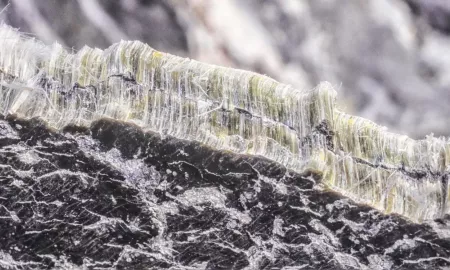Denis Morgan, divisional technical manager and asbestos specialist, Built Environment Services, ESG, gives an overview of the different regulations and legislation concerning the management of asbestos in the rail industry.

Due to its insulating and fire resistant properties, asbestos was widely utilised, not just in buildings in the rail sector and beyond, but also in the development of train rolling stock. Its carcinogenic nature, however, led to the use of asbestos-containing materials (ACMs) in construction and manufacture being banned in the UK in November 1999.
As a result of this ban, the rail sector – just like any other industry – has a legal duty to ensure it has systems in place to manage the risk asbestos poses to the health of workers and the public. But there are numerous regulations relating to asbestos management, which railway companies must comply with to ensure optimum protection for the people using their facilities.
To help those in the industry understand their obligations, SOCOTEC has prepared a breakdown of the key regulations they need to be aware of:
Control of Asbestos Regulations (CAR) 2012 Regulation 4
In force since May 2004, and unchanged in the CAR 2012 update, Regulation 4 stipulates a requirement for the duty-holders of “non-domestic premises” to manage asbestos risk. There is some ambiguity about the precise definition of the term “premises” in the regulations, leaving the document open to interpretation. However, the broad legal view stated in the original Office of Rail Regulation – now known as the Office of Rail and Road (ORR) – Railway Guidance Document, Section Four is that it includes railway lineside structures, railway vehicles and rolling stock, in addition to train stations and other public buildings.
Regardless of the sector, to comply with CAR Regulation 4, the duty-holder has clear obligations to protect building occupants, including:
- Locate ACMs throughout the premises and assess the risk posed to health
- Keep up-to-date records about the location of asbestos
- Develop a risk management plan, and update it regularly as conditions across the premises change
- Inform people carrying out maintenance and repairs in affected structures about the presence of ACMs, and take steps to minimise risk
REACH Enforcement (Amendment) Regulations 2013
The prohibition of asbestos in building fabrics comes under the remit of the EU’s REACH (Registration, Evaluation, Authorisation and Restriction of Chemicals) Regulations. However, an Exemption Certificate issued by the Office of Rail Regulation in 2014 has lifted some restrictions against the marketing and use of a railway vehicle or component suspected of containing ACMs where there is no risk posed to the public or workers.
This allows the sale or lease of a product featuring ACMs, as long as the requirements of Schedule 5A of REACH are met, including:
- Confirming that the vehicle or component was in service or installed before January 2005
- Ensuring that the risk to health has been properly assessed and controlled
- Taking reasonable steps to remove the ACMs, unless it can be demonstrated that removal would increase the health risk
- Keeping accurate records about the location of ACMs in the vehicle or component
Under REACH and the ORR Exemption Certificate, the rail sector still has a duty to monitor and control asbestos throughout its vehicles. However, by allowing them to remove ACMs only where they present a risk to health, the regulations eliminate the need for unnecessary asbestos removal, saving the industry more than £130 million from their maintenance bills in the next 10 years.
Waste Classification WM3 2015
This provides guidance on best practice with regards to controlling waste suspected of containing asbestos. It offers a number of recommendations relating to the management of materials at the end of their life, in the event asbestos is detected, to minimise the risk to the public.
To meet the guidelines, rail organisations should:
- Assess whether asbestos is present as free dispersible fibres, and makes up more than 0.1 per cent of the waste. If ACM fragments are visually identifiable, this can be sufficient to characterise the waste as hazardous
- Take steps to safely dispose of waste where high levels of asbestos fibres have been detected
Managing the risk
The ban on the use of ACMs in the built environment may have been in place for 16 years, but asbestos still presents a risk to health. As such, it’s crucial that organisations both in the rail sector and other industries have in place measures to safeguard building occupants and comply with regulations.
So where should rail organisations start to ensure they meet these goals? Our advice is to, first and foremost:
- Identify all the hazards on the premises
- Work out the most appropriate controls for the needs of the property and put them in place
- Appoint a duty-holder for the premises, sharing responsibility where the property is leased
- Seek expert support where needed
Managing asbestos risk is more than just a legal requirement, it is crucial to protect the health and wellbeing of workers and anyone else using the railway. Organisations should talk to asbestos experts to ensure they fully understand their legal duties, and to receive guidance on putting in place the most appropriate measures to manage risk throughout their premises.
Do you need support in managing asbestos risk in your workplace?
Our Asbestos Management and Consultancy team can provide a comprehensive range of services to ensure full compliance.

You might also like







Add new comment